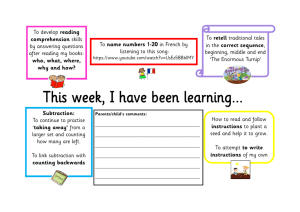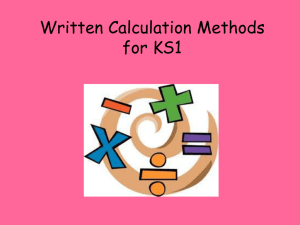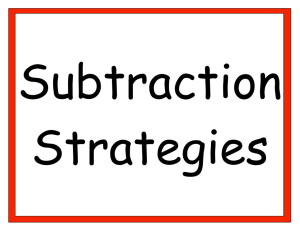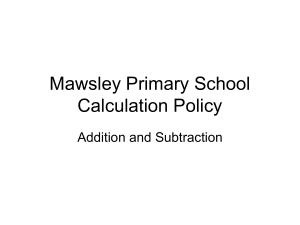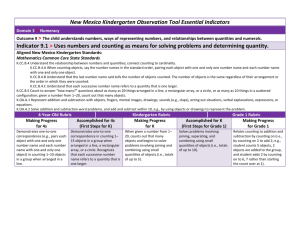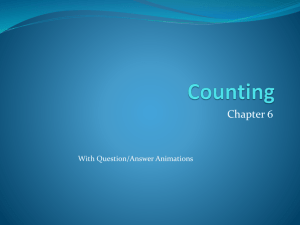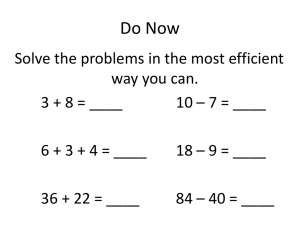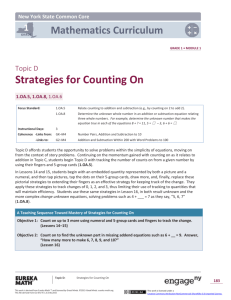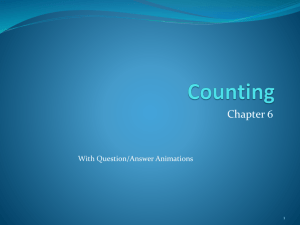The Product Rule
advertisement
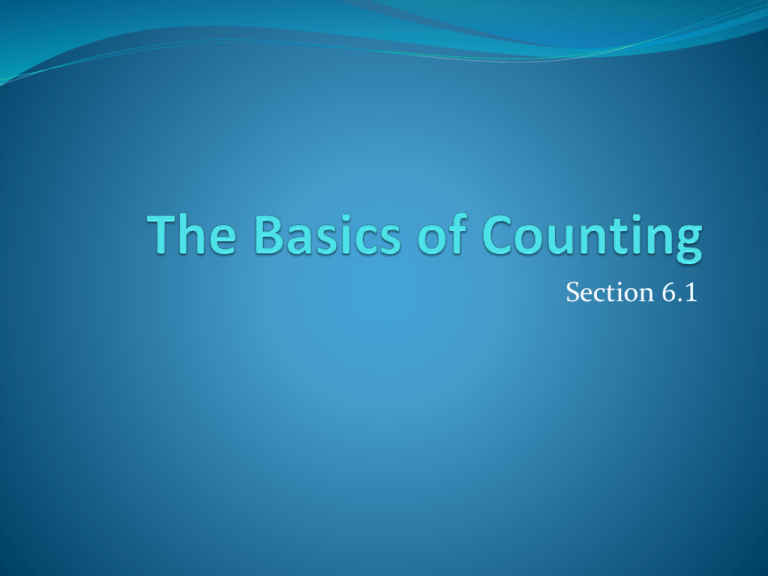
Section 6.1 Section Summary The Product Rule The Sum Rule The Subtraction Rule Examples, Examples, and Examples Tree Diagrams Basic Counting Principles: The Product Rule The Product Rule: A procedure can be broken down into a sequence of two tasks. There are n1 ways to do the first task and n2 ways to do the second task. Then there are n1∙n2 ways to do the procedure. Example: How many bit strings of length seven are there? Solution: Since each of the seven bits is either a 0 or a 1, the answer is 27 = 128. The Product Rule Example: How many different license plates can be made if each plate contains a sequence of three uppercase English letters followed by three digits? Solution: By the product rule, there are 26 ∙ 26 ∙ 26 ∙ 10 ∙ 10 ∙ 10 = 17,576,000 different possible license plates. Counting Functions Counting Functions: How many functions are there from a set with m elements to a set with n elements? Solution: Since a function represents a choice of one of the n elements of the codomain for each of the m elements in the domain, the product rule tells us that there are n ∙ n ∙ ∙ ∙ n = nm such functions. Counting One-to-One Functions: How many one-to-one functions are there from a set with m elements to one with n elements? Solution: Suppose the elements in the domain are a1, a2,…, am. There are n ways to choose the value of a1 and n−1 ways to choose a2, etc. The product rule tells us that there are n(n−1) (n−2)∙∙∙(n−m +1) such functions. Telephone Numbering Plan Example: The North American numbering plan (NANP) specifies that a telephone number consists of 10 digits, consisting of a three-digit area code, a three-digit office code, and a four-digit station code. There are some restrictions on the digits. Let X denote a digit from 0 through 9. Let N denote a digit from 2 through 9. Let Y denote a digit that is 0 or 1. In the old plan (in use in the 1960s) the format was NYX-NNX-XXX. In the new plan, the format is NXX-NXX-XXX. How many different telephone numbers are possible under the old plan and the new plan? Solution: Use the Product Rule. There are 8 ∙2 ∙10 = 160 area codes with the format NYX. There are 8 ∙10 ∙10 = 800 area codes with the format NXX. There are 8 ∙8 ∙10 = 640 office codes with the format NNX. There are 10 ∙10 ∙10 ∙10 = 10,000 station codes with the format XXXX. Number of old plan telephone numbers: 160 ∙640 ∙10,000 = 1,024,000,000. Number of new plan telephone numbers: 800 ∙800 ∙10,000 = 6,400,000,000. Counting Subsets of a Finite Set Counting Subsets of a Finite Set: Use the product rule to show that the number of different subsets of a finite set S is 2|S|. (In Section 5.1, mathematical induction was used to prove this same result.) Solution: When the elements of S are listed in an arbitrary order, there is a one-to-one correspondence between subsets of S and bit strings of length |S|. When the ith element is in the subset, the bit string has a 1 in the ith position and a 0 otherwise. By the product rule, there are 2|S| such bit strings, and therefore 2|S| subsets. Product Rule in Terms of Sets If A1, A2, … , Am are finite sets, then the number of elements in the Cartesian product of these sets is the product of the number of elements of each set. The task of choosing an element in the Cartesian product A1 ⨉ A2 ⨉ ∙∙∙ ⨉ Am is done by choosing an element in A1, an element in A2 , …, and an element in Am. By the product rule, it follows that: |A1 ⨉ A2 ⨉ ∙∙∙ ⨉ Am |= |A1| ∙ |A2| ∙ ∙∙∙ ∙ |Am|. Basic Counting Principles: The Sum Rule The Sum Rule: If a task can be done either in one of n1 ways or in one of n2 ways to do the second task, where none of the set of n1 ways is the same as any of the n2 ways, then there are n1 + n2 ways to do the task. Example: The mathematics department must choose either a student or a faculty member as a representative for a university committee. How many choices are there for this representative if there are 37 members of the mathematics faculty and 83 mathematics majors and no one is both a faculty member and a student. Solution: By the sum rule it follows that there are 37 + 83 = 120 possible ways to pick a representative. The Sum Rule in terms of sets. The sum rule can be phrased in terms of sets. |A ∪ B|= |A| + |B| as long as A and B are disjoint sets. Or more generally, |A1 ∪ A2 ∪ ∙∙∙ ∪ Am |= |A1| + |A2| + ∙∙∙ + |Am| when Ai ∩ Aj = ∅ for all i, j. The case where the sets have elements in common will be discussed when we consider the subtraction rule and taken up fully in Chapter 8. Combining the Sum and Product Rule Example: Suppose statement labels in a programming language can be either a single letter or a letter followed by a digit. Find the number of possible labels. Solution: Use the product rule. 26 + 26 ∙ 10 = 286 Counting Passwords Combining the sum and product rule allows us to solve more complex problems. Example: Each user on a computer system has a password, which is six to eight characters long, where each character is an uppercase letter or a digit. Each password must contain at least one digit. How many possible passwords are there? Solution: Let P be the total number of passwords, and let P6, P7, and P8 be the passwords of length 6, 7, and 8. By the sum rule P = P6 + P7 +P8. To find each of P6, P7, and P8 , we find the number of passwords of the specified length composed of letters and digits and subtract the number composed only of letters. We find that: P6 = 366 − 266 =2,176,782,336 − 308,915,776 =1,867,866,560. P7 = 367 − 267 = 78,364,164,096 − 8,031,810,176 = 70,332,353,920. P8 = 368 − 268 = 2,821,109,907,456 − 208,827,064,576 =2,612,282,842,880. Consequently, P = P6 + P7 +P8 = 2,684,483,063,360. Basic Counting Principles: Subtraction Rule Subtraction Rule: If a task can be done either in one of n1 ways or in one of n2 ways, then the total number of ways to do the task is n1 + n2 minus the number of ways to do the task that are common to the two different ways. Also known as, the principle of inclusion-exclusion: Counting Bit Strings Example: How many bit strings of length eight either start with a 1 bit or end with the two bits 00? Solution: Use the subtraction rule. Number of bit strings of length eight that start with a 1 bit: 27 = 128 Number of bit strings of length eight that start with bits 00: 26 = 64 Number of bit strings of length eight that start with a 1 bit and end with bits 00 : 25 = 32 Hence, the number is 128 + 64 − 32 = 160. Tree Diagrams Tree Diagrams: We can solve many counting problems through the use of tree diagrams, where a branch represents a possible choice and the leaves represent possible outcomes. Example: Suppose that “I Love Discrete Math” T-shirts come in five different sizes: S,M,L,XL, and XXL. Each size comes in four colors (white, red, green, and black), except XL, which comes only in red, green, and black, and XXL, which comes only in green and black. What is the minimum number of stores that the campus book store needs to stock to have one of each size and color available? Solution: Draw the tree diagram. The store must stock 17 T-shirts.
